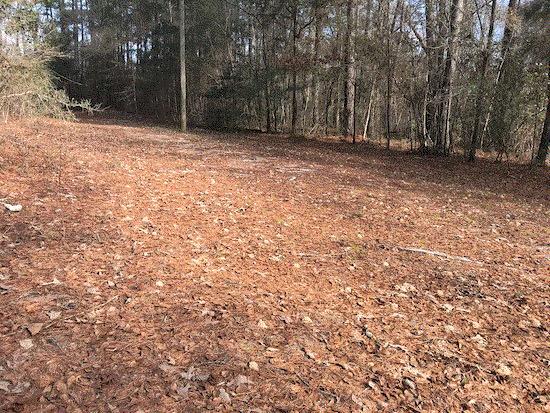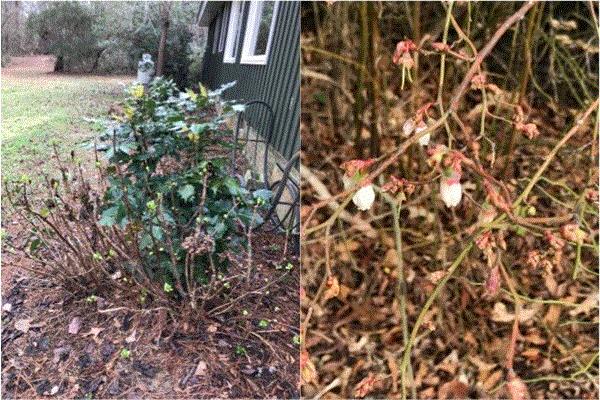Ground nesting bees
I can't believe it—this newsletter is going into its third year! Thank y’all for your continuing support.
Please continue to send me your mystery creatures. Once in a while I’ll look at a picture I want to put up as the “What the … ?” creature, stop myself and think, “Now, have I already shown this one before?”
Case in point: I took a picture of thousands of ground-nesting bee nest entrances under the power line to my house last week. This is the thickest crop of ground-nesting bees I’ve seen in the past seven years. My neighbor, Donna, also found a bunch of them at her place. Of course, I wanted to share the fun observation with you. But I had a funny feeling that I already talked about them. So, I looked up my old writings, and sure enough, I had already used them for my “What the … ?” in 2018. Well, shoot!

I didn't give a whole lot of information about these ground-nesting bees last time, so it can't hurt to talk in a little more detail this time.
Quite a few species of miner or digger bees make use of bare, sunny, sandy spots for procreation. Females bustle in and out of the underground burrows, where they build nests with multiple chambers, each stuffed full of pollen and other provisions for their developing young. Males are also flying just above the ground, hoping to get lucky with a willing female.
Although the nests appear in huge densities, these miner or digger bees are actually solitary. Unlike honey bees or yellowjackets, which live together in the same nest, each miner or digger bee female digs her own burrow and minds her own business.
(Photo credit: Donna Goodman)
The bees come in all different colors and are usually much smaller than honey bees. Despite their number, they aren’t aggressive at all unless, of course, you catch and try to squish one in your bare hand. But their nests can be a nuisance to some.
Not me, though. I think they are actually kind of fun. They are also important pollinators. The past two summers, I conducted a study documenting what kind of bees come to ornamental plants. Sweat bees, miner bees and digger bees made up more than 60% of the pollinators that visited my flower plots. Honey bees, on the other hand, were completely absent even though I kept two hives less than a mile away.
I usually just let the ground-nesting bees be, and they move on in a couple of weeks. Considering my fondness for the ground-nesting bees, it perplexes me why anyone would want to get rid of them. Well, yes, some people are allergic to bee stings so there is a legitimate medical reason for not wanting the bees nearby. But, most folks who ask me for a management recommendation do so because “the bees made a mess of my lawn!” Okay, in that case, just turn on your sprinkler to drive them off. Better yet, grow better grass.

Very confused insects and plants
In addition to their numbers, there is also one thing rather unusual about the ground-nesting bees this year—they’re a bit earlier than usual. It may have something to do with the upper 70s weather we had all last week. A lot of creatures are also confused.
Camellia (japonica) is in full bloom, which I’d expected. But, the fragrant tea olive is also in fuller bloom than what I’d expected for winter. Hydrangeas were breaking buds and blueberries were flowering. My fear came true when I found the tender tips of hydrangea, blueberry and tea olive all frost-bitten this morning. I saw several sulfur butterflies fluttering around looking for flowers. Judging by the feeble flapping of their wings, not all of them found one. My wife’s dog, Sake, was having fun hunting lizards. Both the butterflies and the lizards are gone now.

It’s going to drop down to low 20s again at my homestead tonight. This big swing in temperature really confused a lot of creatures of the wild, myself included.

A look back at pesticides introduced in 2019
2019 was a busy year for pesticide introduction. In addition to the 10 biofungicides and insecticides that added industrial hemp to their labels, and Endeavor expanding its label for use on vegetable transplants, there are other products that have been registered for use in our industry.
Acelepryn insecticide by Syngenta is now registered for greenhouse and nursery uses. Acelepryn contains chlorantraniliprole, and was first introduced to the turf and landscape market in 2008 by DuPont. The expanded label includes foliar sprays against leaf-feeding caterpillars, soil application (via injection, drench or spray) and container drench application against white grubs, aphids and lace bugs, and trunk spray application against clearwing borers.
Alluma, an insecticide, insect repellent, miticide and pesticide synergist, was introduced by Sym-Agro. Alluma contains garlic oil, and can be used on various fruits, nuts, vegetables, herbs, grains, grasses, mushrooms and many other crops in both indoor and outdoor production. Alluma has both contact and translaminar activity against a wide range of insects and mites.
Azera Pro insecticide was introduced by MGK. Azera Pro is a combination of pyrethrins and azadirachtin, with activity against a broad spectrum of pests. Azera Pro is OMRI certified. It can be applied as a foliar spray or a medium drench on ornamentals, vegetables, fruits, nuts, herbs, spices and other crops.
FireWorxx herbicide was introduced by OHP. This is a non-selective burn-down herbicide containing 44% caprylic acid and 36% capric acid. Targets include broadleaf weeds, grasses, algae and mosses in nurseries, landscapes and greenhouses, and around buildings and structures, sidewalks and in gravel.
Fuerte herbicide was introduced by OHP. Fuerte is a dustless granular pre-emergent herbicide, containing 0.125% flumioxazin and 0.75% prodiamine. Fuerte is registered for pre-emergent control of grassy and broadleaf weeds in field and container nurseries, landscapes, Christmas tree farms and conifer farms.
Kalmor fungicide/bactericide was introduced by OHP. Kalmor contains copper hydroxide. This product is labeled for management of a wide range of fungal and bacterial diseases on vegetables, herbs, ornamentals, conifers, and fruit and nut trees grown in greenhouses, shadehouses and nurseries, as well as algae control on non-residential turf (golf courses, sod farms, cemeteries and industrial sites).
Obtego biofungicide was introduced by SePRO, and contains Trichoderma asperellum (strain ICC 012) and Trichoderma gamsii (strain ICC 080). It is used for preventive treatment of pathogens that attack roots and collars, including fusarium, phytophthora, pythium, rhizoctonia and thielaviopsis. It is labeled for ornamentals, fruits, herbs, vegetables and turf grown in fields, greenhouses, nurseries, landscapes, golf courses, sod farms, and other indoor and outdoor sites.
Pradia insecticide was introduced by OHP. Pradia contains two active ingredients—cyclaniliprole and flonicamid. Pradia has the same use site and target pests as Sarisa (see below), but with greater efficacy against thrips and mealybugs than Sarisa.
Sarisa insecticide was introduced by OHP. Sarisa contains a brand new active ingredient, cyclaniliprole. Sarisa is registered for use on ornamental plants, conifers and non-bearing fruit and nut trees grown in greenhouses, shadehouses and nurseries. Target pests include leaf-feeding caterpillars, beetles and thrips (suppression), as well as sucking insects (adelgids, aphids, lace bugs, mealybugs (suppression), psyllids, soft scales, stink bugs and whiteflies) and others.
Ventigra insecticide was introduced by BASF. The active ingredient of Ventigra is afidopyropen, which is a new active ingredient in IRAC Group 9D. Target pests are aphids, whiteflies, mealybugs and scale insects. Ventigra is registered for use on ornamentals, vegetable transplants and juvenile fruit and nut trees grown in greenhouses, shadehouses, nurseries, landscapes and interiorscapes.
Zio fungicide was introduced by SePRO. The active ingredient in Zio is Pseudomonas chlororaphis strain AFS009. It can be used for management of several diseases in turfgrass, ornamental plants (both indoor and outdoor) and vegetable and fruit transplants, that are caused by pathogens such as botrytis, colletotrichum, fusarium, phytophthora, pythium, rhizoctonia and sclerotinia.






See y'all next time!

JC Chong
Professor of Entomology at Clemson University
This e-mail received by 22,731 subscribers like you!
If you're interested in advertising on PestTalks contact Kim Brown ASAP!